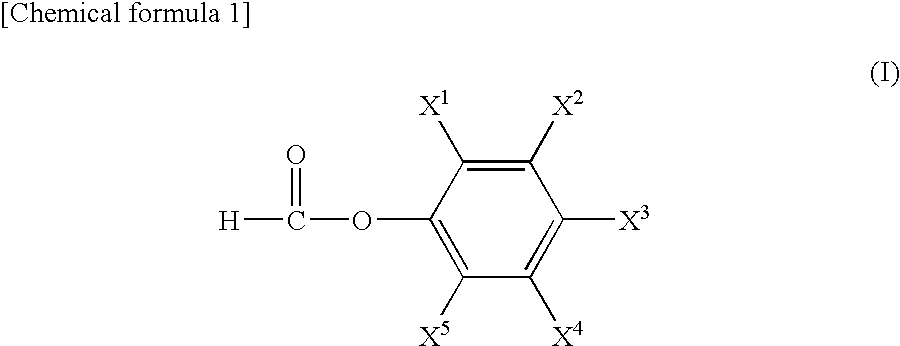Nonaqueous electrolyte solution and lithium secondary battery using same
a lithium secondary battery and electrolyte technology, applied in the direction of non-aqueous electrolyte cells, cell components, electrochemical generators, etc., can solve the problems of lowering battery performance and battery performance, and achieve excellent battery cycling property, excellent battery charactristics, and excellent battery cycling properties
- Summary
- Abstract
- Description
- Claims
- Application Information
AI Technical Summary
Benefits of technology
Problems solved by technology
Method used
Image
Examples
example 1
[Preparation of Nonaqueous Electrolytic Solution]
[0107]A nonaqueous solvent of ethylene carbonate (EC):propylene carbonate (PC):methyl ethyl carbonate (MEC) (volumetric ratio)=30:5:65 was prepared. A nonaqueous electrolytic solution was prepared by dissolving LiPF6 in this solvent as an electrolyte salt to give a concentration of 1 M, and then 2-butyne-1,4-diol diformate was further added to the electrolytic solution in an amount of 0.1% by weight of the nonaqueous electrolytic solution.
[Production of Lithium Secondary Battery and Measurement of Battery Characteristics]
[0108]Ninety-four % by weight of LiCoO2 (positive electrode active material), 3% by weight of acetylene black (conductive material) and 3% by weight of polyvinylidene fluoride (binder) were mixed. A 1-methyl-2-pyrrolidone solvent was added to this mixture and mixed. The resulting mixture was applied on an aluminium foil, dried, pressure-molded and heated, preparing a positive electrode. 95% by weight of an artificial ...
examples 2 to 4
[0110]Nonaqueous electrolytic solutions were prepared, cylindrical batteries of 18650 size were produced and the cycle of charging and discharging was repeated in a manner similar to Example 1 except that 2-butyne-1,4-diol diformate was used as an additive in an amount of 0.5% by weight, 1% by weight and 5% by weight, respectively, of the nonaqueous electrolytic solution. The results are shown in Table 1.
examples 5 to 14
[0111]Nonaqueous electrolytic solutions were prepared, cylindrical batteries of 18650 size were produced and the cycle of charging and discharging was repeated in a manner similar to Example 1 except that phenyl formate, biphenyl formate, 4-cyclohexylphenyl formate, pentafluorophenyl formate, ethylene glycol diformate, ethylene glycol formate acetate, 2-butene-1,4-diol diformate, 2,5-dimethyl-3-hexyne-2,5-diol diformate, 2,4-hexadiyne-1,6-diol diformate and trimethylolethane triformate were used as additives in an amount of 1% by weight of each of the nonaqueous electrolytic solution. The results are shown in Table 1.
PUM
| Property | Measurement | Unit |
|---|---|---|
| dew point | aaaaa | aaaaa |
| dew point | aaaaa | aaaaa |
| temperature | aaaaa | aaaaa |
Abstract
Description
Claims
Application Information
 Login to View More
Login to View More - R&D
- Intellectual Property
- Life Sciences
- Materials
- Tech Scout
- Unparalleled Data Quality
- Higher Quality Content
- 60% Fewer Hallucinations
Browse by: Latest US Patents, China's latest patents, Technical Efficacy Thesaurus, Application Domain, Technology Topic, Popular Technical Reports.
© 2025 PatSnap. All rights reserved.Legal|Privacy policy|Modern Slavery Act Transparency Statement|Sitemap|About US| Contact US: help@patsnap.com



